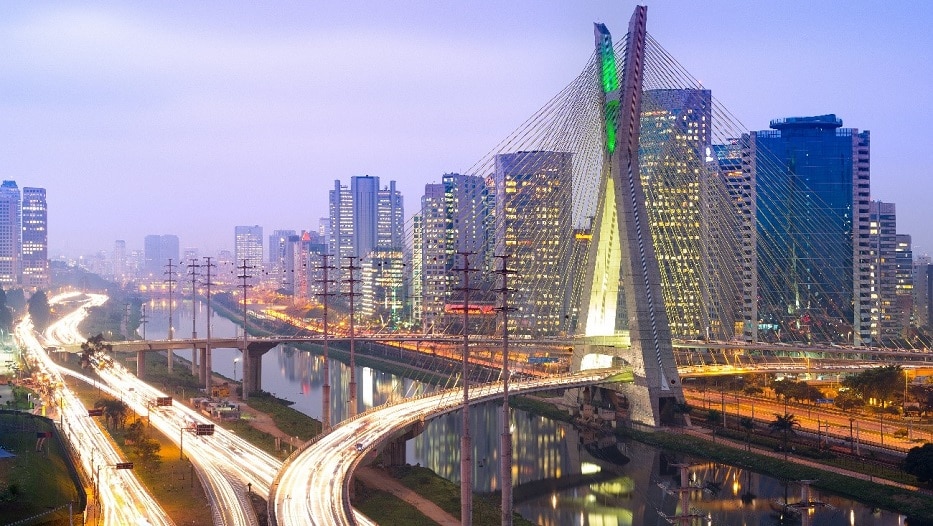Monica Jimenez Hurtado | 10/02/2022
The Development Bank of Latin America (CAF) has published a series of reports that analyze the land transport infrastructure in the region, describing its situation, defining investment needs and identifying the impact of its most relevant projects. Irene de Cubas, a researcher at the Center for Innovation in Transport (CENIT) and co-author of the document addressing the sector in Brazil, speaks to us about the conclusions obtained from the study on the regional road and railway systems.
Brazil’s vast geography makes its road network a fundamental factor in its economic development and well-being. The region has more than 1.7 million kilometers of federal, state and municipal highways, which represents a highway density that is close to 200 km for every 1,000 km2. As Irene de Cubas, a civil engineer and researcher at the Center for Innovation in Transport (CENIT), points out, its greatest strength lies in the prioritization of the sector in recent times. “The construction of highways in the country was a late process, due to little importance being given road transport until the second half of the 20th century. From here it moved to an opposite model that favored highways, buses and trucks as a means of transporting passengers and cargo, with the aims of integrating territory and industrializing the country based on the generation of industrial poles centered on automotive production. Due to this change in investment prioritization, one of the strengths of the road network is the high territorial penetration of the networks,” she explains.
This extensive infrastructure has a deficiency in its development: in terms of territorial coverage, only 15% of the corridor network is paved. “It has consolidation difficulties due to the length of the routes, thus the paved road density is actually 25 km/1,000 km2, which is 30% lower than the regional average of Latin America,” points out De Cubas. This deficiency, as the civil engineer explains to us, is in an unequal manner: of the 1.3 million unpaved kilometers, 1.2 million are in the municipal network. However the federal network has 86% of the paved roads. “According to the National Confederation of Transport (Confederación Nacional de Transporte, CNT), in 2018, 42% of the paved road network was in an ‘optimal’ state, 7% in a ‘good’ state and 37% in a ‘regular’ state. In the case of the state network, comprising 225,000 kilometers, approximately half of the roads are paved. Additionally, nearly 10,000 km of the network are highways and many sections are under concession. São Paulo, with almost 5,000 km of highways, has the largest network of this type in the country and the greatest number of concession roads,” the expert assures, adding, in addition, that these concessions have been concentrated in operational roads for improvements and maintenance, which differ from other international experiences where the private sector “builds and operates new networks”.
With regard to the traffic it sustains, passenger transport shows a downward trend, since it has been losing importance in relation to air mobility on regional routes. “In 2010, nearly 50 million passengers were recorded, with 23,476 million passengers per kilometer, while in 2016 the figures were 39 million passengers and 19,013 million passengers per kilometer. Even so, the sector has high modal relevance: in 2017, it transported 44.4% of the total number of passengers, with 1.1 million trips made,” says De Cubas.
Cargo transport, for its part – according to the Inter-American Development Bank (IDB) – is concentrated with 60% of the total volume being handled in the country, with iron, cement, soy and derivatives being the main solid products transported.
A strong railway activity
As Irene de Cubas explains to us, Brazil has the most extensive and heavily used active railway system in Latin America. “This system is mostly comprised of 1-meter-wide tracks, laid in the Atlantic and southern coastal states, which coexists with a historic subnetwork of tracks at a width of (1,600 mm) originally developed in the states of Rio de Janeiro, São Paulo and Minas Gerais,” she specifies.
Railway operations were affected by the prioritization of roads which ended up capturing part of cargo transport and most of passenger transportation. However, the Brazilian economy contains mining and heavy industrial activities on such a scale that, for those businesses, railway is the irreplaceable mode of transport. “This reality, in addition to the enormous development of agro-industry, which also generates very high traffic volumes, and the large transportation distance inherent to Brazil, establishes the participation of the railway mode in domestic transport as the highest in Latin America, in the order of 20% of tons per kilometer,” adds the CENIT researcher.
Both modes of transport have a series of reference infrastructures, which support the traffic of the region.
In the road sector, several routes have similar Annual Average Daily Traffic (AADT) values, with the exception of the BR-262 highway in Belo Horizonte and the BR-116 in the state of Rio Grande del Sur, which far exceed the others. In the second order of AADT magnitude, there are the BR-40 highways in Belo Horizonte and BR-101 in Porto Belo.
As for the railway sector, Brazil is the only country in the region that, in the last 25 years, has tackled large infrastructure-related projects in order to generate structural expansions in its railway network, mainly in the north of the country. The most ambitious of all of them is for the North-South railway. The important corridors are on the east coast of the country, concentrating cargo volumes in the areas of São Paulo and Rio de Janeiro.
Shortcomings and challenges in interconnections
Despite the figures, and as indicated by the report published by the CAF, there is no good connection in the region between freight trucks and port access. As Irene de Cubas assures, the immense continental dimensions hinder this connection between nodes, both by road and rail. “The Amazon area creates a natural barrier for the construction and connection of railways, and in the case of roads, these are dirt or unpaved roads. Therefore, both road and railway infrastructure networks are concentrated on the country’s east coast,” she explains.
Transnationally, the region has opted to encourage the development of links with Peru, Bolivia, Argentina or Chile, through the Initiative for the Integration of the Regional Infrastructure of South America (Integración de la Infraestructura Regional Suramericana, IIRSA). “Among the international railway connections, the link to Bolivia stands out, whose network has the same track width as the Brazilian network in the contact region. Activity is somewhat strong, as it connects the Bolivian eastern production center with the area of São Paulo and the port of Santos, the Brazilian industrial heart. This connection, that crosses the Paraguay River between Corumbá and Quijarro, is part of the so-called Bioceanic Corridor, whose central project is the link between the Andean and Eastern networks of Bolivia, which would connect the aforementioned Brazilian areas with the Bolivian Altiplano,” explains Irene de Cubas.
The other bordering countries – Peru, Colombia, Venezuela, Guyana and Suriname – have not had tracks that reach the respective borders, although there is a connection with Peru that gives way to production through Pacific ports, “with this being a unique proposal, since Brazil’s traditional concern has been to take its production to its own ports”.
The main improvement plans by the competent institutions, and as indicated by the study conducted by CAF, go through a portfolio of high-impact inter-urban land transport projects. “Among the projects selected as priority for the road sector in Brazil, capacity increases can be identified in sections with high vehicular flow, as well as maintenance and resurfacing plans,” she points out.
In the railway environment, the new planned roads comprise core corridors in the central region of the country, which historically lacked railways and where there is high potential demand. “Two integration projects are also included with networks from neighboring countries, one of which is the recovery and strengthening of the infrastructure of an existing track that links to the Bolivian network,” she explains. “The prioritization analysis shows that the main national corridors are concentrated in the central and southern regions of Brazil and, in most cases, have the Greater São Paulo metropolitan area as the focal point. Some of these axes have international extensions to Peru – through the aforementioned Bioceanic Corridor – and in the main connections of the Southern Common Market (Mercosur) with Argentina and the ports of the Chilean Pacific, directly or through Paraguay or Bolivia.”
Future perspectives and challenges
The country’s economic outlook points to annual GDP growing at an average of 2.8%, while the population will grow at 0.1% per year. These factors indicate that, together, there will be a significant growth in transport demand. “Vehicular traffic will grow by 2.4% per year. This will determine that the flow of vehicles will grow by 49% from the current level up to 2030 and 75% by 2040,” clarifies the CENIT researcher. These perspectives require an investment effort, which at present is not being made in the region. “Quantification of the infrastructure gap results in Brazil having transport infrastructure of $1,900 per inhabitant, a value somewhat lower than the Latin American average. In the future, if the country wants to close the gap with developed countries, investments up to 2040 should represent 4.1% of annual GDP, plus assigning an additional 1.1% for maintenance. This would imply increasing the amounts of current investment by 9-10 times, a value that is estimated to be difficult to reach,” predicts De Cubas.
The expert also points to the main lines of action that synthesize the strategic objectives arising from the diagnosis made by CAF:
- The first line of action is intermodal integration, as there is no good connection between freight trucks and port access. In order to increase the efficiency of freight truck unloading times, logistical support infrastructure should be built and processes should be improved through digitalization.
- The second point of the road map is road safety, because the geometric layouts are not updated to limit vehicle speeds. In order to improve the geometric characteristics of federal roads, designs should be reviewed with a road safety approach.
- Finally, the third axis of the land sector’s action strategy is the digitalization and modernization of networks, as databases are needed for adequate road asset management. For this purpose, technological tools should be used to implement asset management systems and to apply pavement management systems, inventory management systems and capacity plans, among others.
Article collaborator:
 Irene de Cubas, Department of Transport Economics at CENIT, is a Road, Canal and Port Engineer from the Polytechnic University of Catalonia (Universidad Politécnica de Cataluña, UPC), with a specialization in Transport and Infrastructure. She has developed her professional experience at the Department of Transport Economics, both in international projects and in transportation studies conducted by the Catalan Administration. Some of the main projects she is working on as a consultant are: “Ex-Post Evaluation of Department Infrastructure Projects” of the Territory and Sustainability of the Government of Catalonia, the “Last Mile Distribution White Book” of the Metropolitan Transport Authority of Barcelona (Autoridad Metropolitana del Transporte, ATM), and “Analysis of Investments in the Latin American Transport Sector up to 2040” of the Development Bank of Latin America (CAF).
Irene de Cubas, Department of Transport Economics at CENIT, is a Road, Canal and Port Engineer from the Polytechnic University of Catalonia (Universidad Politécnica de Cataluña, UPC), with a specialization in Transport and Infrastructure. She has developed her professional experience at the Department of Transport Economics, both in international projects and in transportation studies conducted by the Catalan Administration. Some of the main projects she is working on as a consultant are: “Ex-Post Evaluation of Department Infrastructure Projects” of the Territory and Sustainability of the Government of Catalonia, the “Last Mile Distribution White Book” of the Metropolitan Transport Authority of Barcelona (Autoridad Metropolitana del Transporte, ATM), and “Analysis of Investments in the Latin American Transport Sector up to 2040” of the Development Bank of Latin America (CAF).





